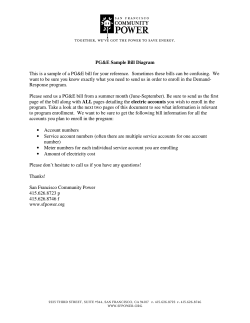
DISASTER PREPARING YOUR SMALL BUSINESS FOR A DISASTER
DIS AST ER PREPARING YOUR SMALL BUSINESS FOR A DISASTER San Francisco provides a culturally diverse and economically bountiful environment for over 65,000 small businesses, but living and working here require attention to more than the moderate climate and spectacular views. Businesses which operate successfully in San Francisco must incorporate emergency preparedness and planning activities into their daily business activity. Businesses of all sizes must be prepared to respond to emergencies and disasters of all sizes. Disasters often cause small businesses to relocate or cease operation temporarily, which may lead to substantial economic and personal hardship. Many businesses that are forced to close after a disaster never reopen at all. Thorough planning for the safety and survival of your employees, customers and infrastructure is essential to maximize the chances for recovery. This guide can help you get started on a plan to prepare your small business. Begin now! San Francisco is vulnerable to these and other serious emergencies: Effective emergency planning includes these critical activities: • Identify and assess vulnerabilities and capabilities • Develop plans for emergency response, business resumption and relocation • Assemble emergency supplies and response kits • Exercise your plans • Educate and train your staff in emergency preparedness and response • Back up data and copy important records, and arrange for offsite storage • Review insurance coverage • Participate in the Neighborhood Emergency Response Team (NERT) program • Earthquake • Fire • Electrical or other utility outage • Severe storm • Hazardous materials spill • Tsunami • Act of terrorism S A N F R A N C I S C O S M A L L B U S I N E S S S A N F R A N C I S C O M A Y O R ’ S O F F I C E C O M M I S S I O N O F E M E R G E N C Y S E R V I C E S Emergency Planning Checklist Identify vulnerabilities and threats • List the disasters that may strike your business and the damage they may cause to the business • Analyze the impact of a cyber attack on your business and/or its web site • Conduct a business impact analysis for potential emergency scenarios Plan for emergency assistance and support to employees • Consider financial assistance such as cash advances or salary continuation • Offer reduced or flexible work hours • Provide crisis counseling, day care and other needed services List your company’s capabilities and resources for responding to emergencies • Identify key personnel and their skills (first aid, multiple language, crisis management) • Identify insurance provider, vendors and other resources that will be helpful in business resumption • Inventory equipment and supplies that may be useful following an emergency Business resumption plan • Prepare a list of equipment, supplies, forms and other items needed to ensure business continuity • Identify alternate sites for relocation of the business • List key customers/clients and vendors that need to be notified in the event of a move Identify and post evacuation routes and assembly areas • Identify primary and alternate routes out of the building • Choose an assembly area nearby but away from potential danger, identify nearest NERT staging area • Establish procedures for employees to check in and be accounted for after an emergency Plan for the effective use of your staff • Establish an emergency management organization like the Incident Command System • Designate key staff as emergency coordinators,provide response roles for all staff • Encourage employee personal and household preparedness Establish a notification plan and emergency contact list • Maintain up to date contact information on employees, vendors, building owner/manager, etc. • Record the location and number of the nearest police and fire stations and hospital • Designate a phone or voice mail number at your business for staff to use to check in after an emergency Establish an emergency training plan • Orient employees to your specific business resumption and recovery plans • Provide staff training in first aid and CPR • Contact the Fire Department to schedule Neighborhood Emergency Response Team training for staff Plan for the protection of important business data and records • Schedule daily backups of electronic data • Arrange for offsite storage of data and copies of key records • Keep rosters and important business records up to date Develop an emergency communications plan • Determine who will have communication needs – off site employees, emergency responders, vendors • Assess primary and alternate communication systems – cell phones, pagers, radios, the internet • Identify employees with amateur radio licenses and equipment Emergency Preparedness Checklist Protect critical systems such as computers, telephone equipment and other sensitive devices from failure or attack • Install uninterruptible power supplies and surge protectors on key circuits • Install antivirus software on computers and networks • Install firewall software on networks • Update system protection software regularly Assemble and store emergency supplies • First aid kit, sized for the business • Portable radio/TV and extra batteries • Flashlights or lanterns and extra batteries • Work gloves and protective clothing • Emergency response tools • Emergency food and water • Sanitation supplies • Blankets • Dust masks • Plastic sheeting, tarps, duct tape • Two-way handheld radios for emergency communication Implement appropriate structural and non-structural hazard mitigation actions • Where possible, upgrade the seismic safety of building structures • Install fire sprinklers • Secure cabinet doors with safety latches • Fasten tall bookcases, cabinets and large hanging objects to walls • Secure free standing shelving units, and make sure objects on shelves will not shake loose and fall • Use hook and loop fasteners to keep computers, cash registers and other valuable items from falling Provide for emergency backup power and lighting • Install a fixed or portable generator powered by diesel, gasoline, propane or natural gas • Consider a small inverter to provide AC power to a device from a battery or vehicle engine • Install battery powered emergency lighting Assemble building site maps and floor plans with the following information identified: • Stairways, exits and fire escapes • Utility valves and shutoffs – electric, gas, water, heating and air conditioning • Fire hydrants and standpipes • Fire extinguishers • Hazardous materials • Locked or restricted areas Contact insurance company, review policy and address any coverage gaps • Review current policies and amount of coverage for loss • Identify coverage gaps – earthquake, flood, etc. • Identify records required by the insurer in the event of a disaster • Assess coverage for business resumption and relocation, payroll, lost income, emergency expenses Conduct regular exercises with employees and modify plans and procedures as necessary • Evacuation and assembly • Fire evacuation • Notification and employee contact • Tabletop exercises to test various scenarios and plans • Emergency communications Small Business Disaster Planning Resources Business Recovery Managers Association - (925) 355-8660 - www.brma.com Building Owners and Managers Association - (415) 362-8567 - www.bomasf.org San Francisco Fire Department, Neighborhood Emergency Response Team (NERT) - (415) 558-3459 - www.sfnert.org Structural Engineers Association of Northern California - (415) 974-5147 - www.seaonc.org Building Occupancy Resumption Program (BORP) – Department of Building Inspection - (415) 558-6104 www.ci.sf.ca.us/dbi/eprep_main.html American Red Cross, Bay Area Chapter - (415) 427-8000 - www.bayarea-redcross.org Mayor’s Office of Emergency Services - (415) 558-2700 - www.sfgov.org/oes SF Ready - www.sfready.org Small Business Administration - www.sba.gov/DISASTER/getready.html Institute for Business and Home Safety (small business disaster planning toolkit) - www.ibhs.org/business_protection/ Business Continuity Institute - www.thebci.org DRI International - www.dr.org/ Operation Fresh Start: Business Recovery (US Department of Energy) - www.sustainable.doe.gov/freshstart/business.htm Disaster Resource Guide - www.disaster-resource.com Global Portal for Business Risk and Continuity Planning - www.globalcontinuity.com Emergency Management Guide for Business and Industry - http://www.fema.gov/library/bizindex.shtm Disaster Recovery Journal (free, subscribe online) - www.drj.com Contingency Planning (free, subscribe online) - www.contingencyplanning.com The Natural Hazards Observer (free, subscribe online) - www.colorado.edu/hazards/o/o.html San Francisco Small Business Commission - (415) 554-6134 - www.sfgov.org/sbc City Hall, Suite 448, 1 Dr. Carlton B. Goodlett Place, San Francisco CA 94102 San Francisco Mayor’s Office of Emergency Services - (415) 558-2700 - www.sfgov.org/oes S A N F R A N C I S C O S M A L L B U S I N E S S S A N F R A N C I S C O M A Y O R ’ S O F F I C E C O M M I S S I O N O F E M E R G E N C Y S E R V I C E S
© Copyright 2025





















